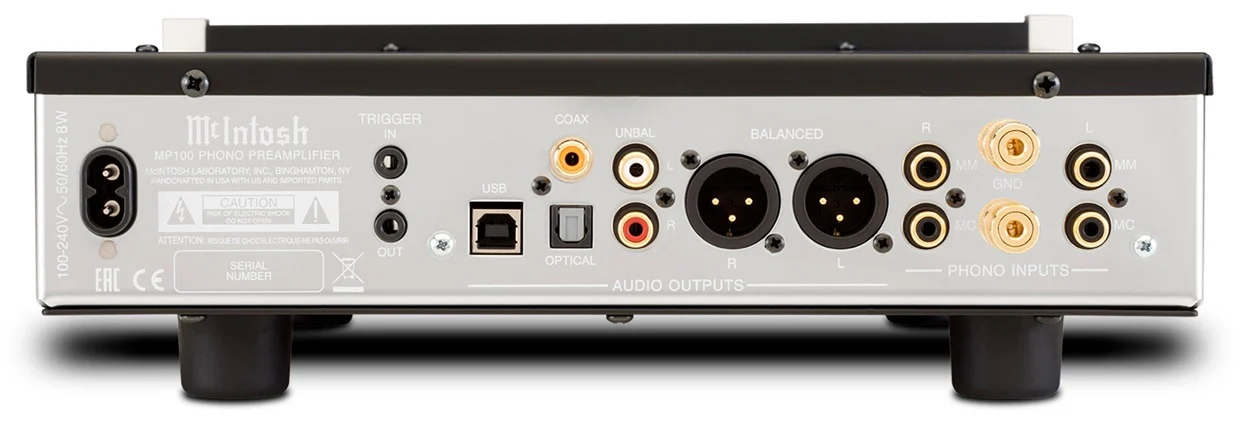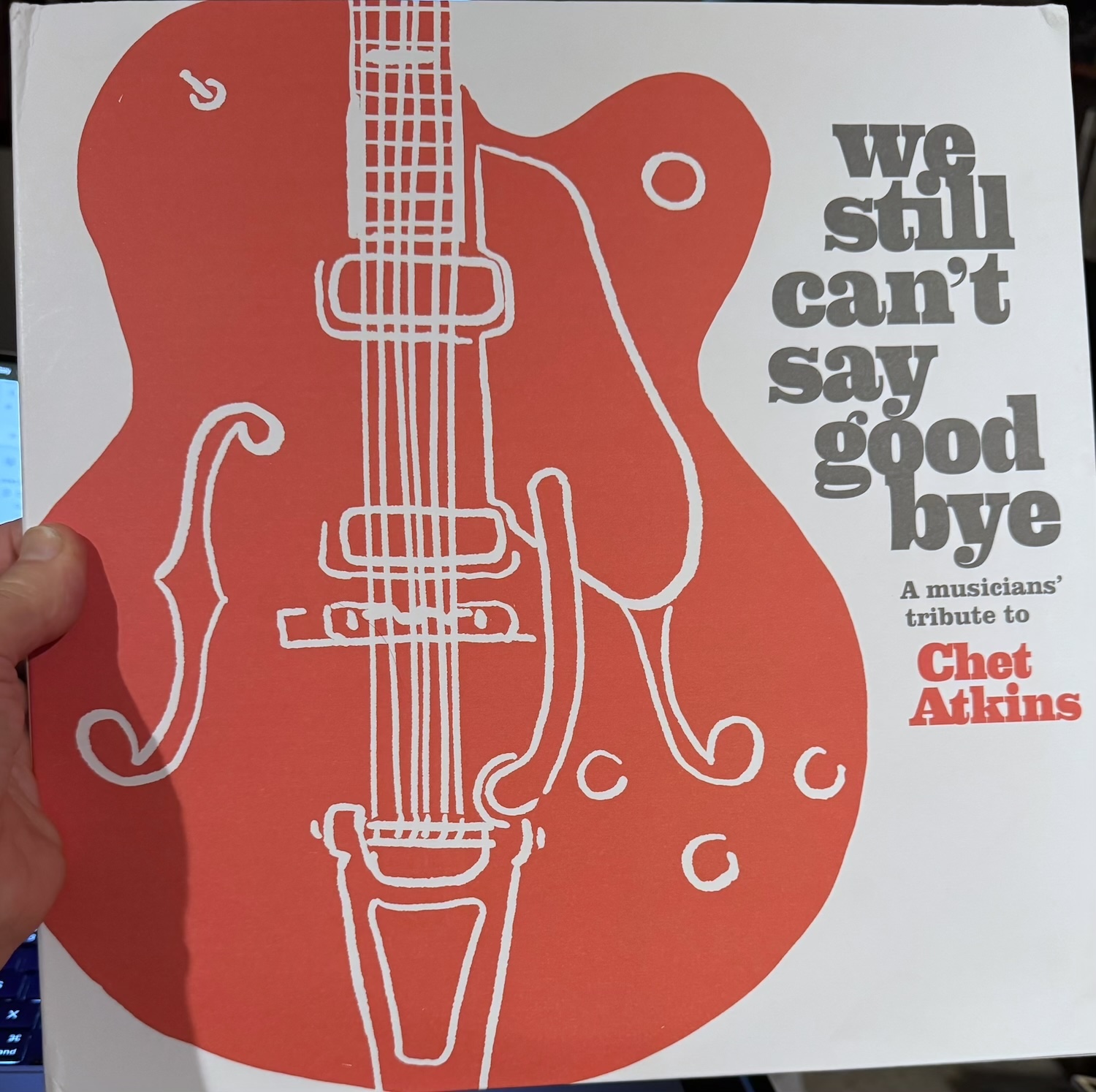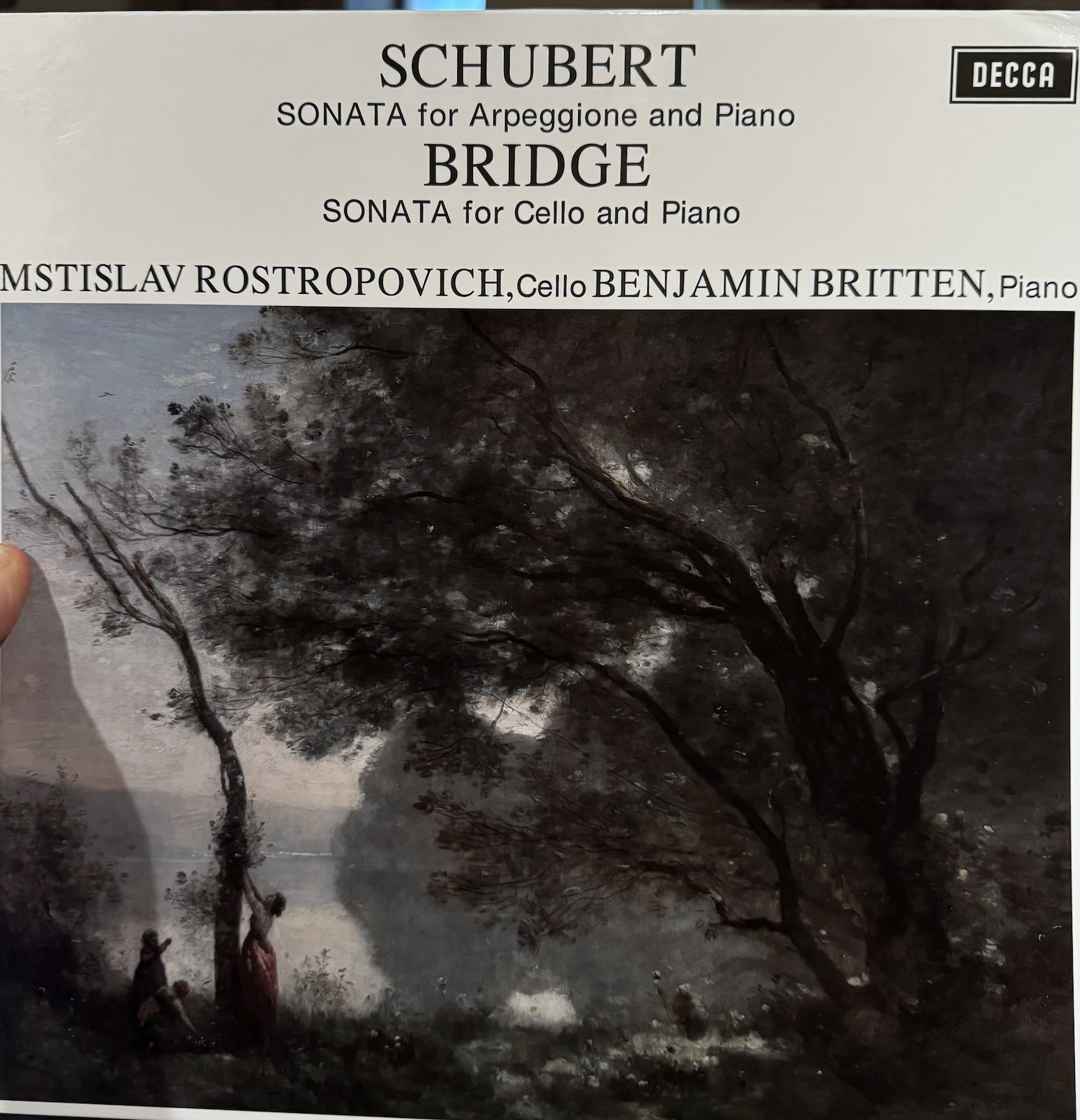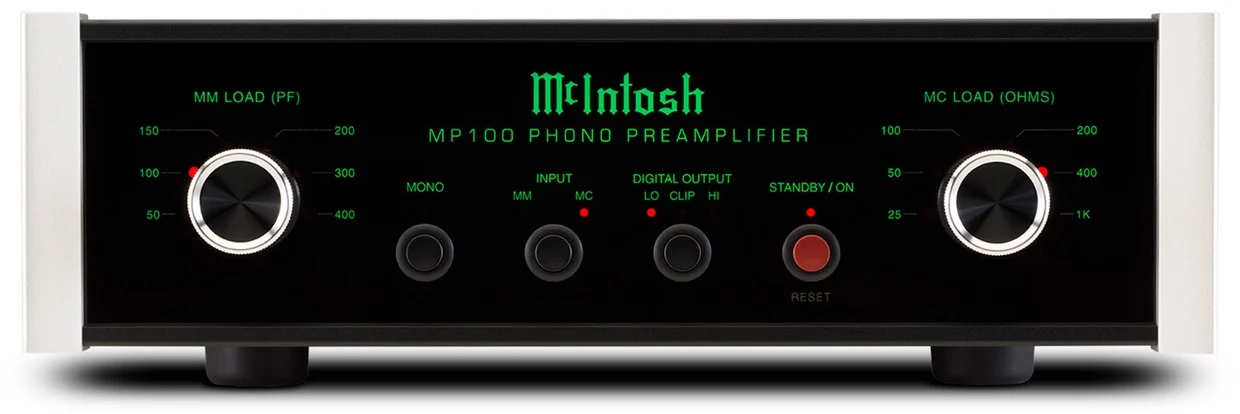McIntosh's First Stand-Alone Phono Preamp Is A Real Smoothie
and it has a defeatable built-in analog to digital converter
Hard to believe, but McIntosh's recently introduced MP100 is the storied company's first stand-alone phono preamplifier. Though at $2000 it's not stratospherically priced, it delivers both an impressive features set and the suave sonic goods, feel and build quality you'd expect from McIntosh. and of course, you could even say it glows (green).
This is an accidental review, though shame on me for not asking for one to review sooner. It was on my list, but when the Thunderbolt cable stopped working—needed to connect my Lynx HiLo A/D, D/A converter to my computer —and I was having difficultly finding a replacement since Apple no longer supports the connection, I was without A/D and I needed it!
I called my friend Fernando at SkyFi Audio located a few miles from home (and within blocks of my previous home) and he offered to lend me this MP100, which I've kept for too long because after using it "in a pinch" I figured I might as well get the review out of the way, which turned out to be a very pleasurable task.
Features
The compact MP100 features separate single-ended moving magnet and moving coil inputs, a choice of six front panel selectable MM capacitance and six MC resistive load settings, a "mono" button, single ended RCA and balanced XLR outputs (available simultaneously) and a built-in 96k/24 bit A/D converter accessible via SPDIF RCA, optical and USB-A connections. The digital output has front panel selectable "high" and "low" settings plus a "clipping" LED that warns if you've overloaded the circuit. Digital outputs can be used to "rip" vinyl to files, or as a signal source for a digital preamplifier.

Rear panel layout is clean and McIntosh-chrome-y, just as the front panel is McIntosh glass-green. There's also a remote trigger and a pair of plated ground lugs. Push the stand-by button and the MP100 comes to life with that famous green glow (using LEDs) that sets audiophile hearts on fire.
Inside are separate MM and MC boards using close tolerance resistors and capacitors. Digital logic circuits drive electromagnetic input switches. A defeatable Auto-off feature puts the until in standby if it doesn't detect an incoming signal. Pressing and holding the "Digital Input" button until the trio of LEDs extinguish, turns off the digital output to preserve analog sonic purity. Let's call this "a taste of McIntosh" at a moderate price point.
Set-up and Use
To some degree the MP100 is aimed at vinyl "newbies" or those returning to the most robust physical format (have you heard that much of the 1990s music masters stored on hard drives, even under the best conditions at Universal's Iron Mountain storage facilities, can no longer be accessed?).
This is an easy to use phono preamp free of rear or bottom panel DIP switches and features sensible set and settable parameters. MM and MC gain are fixed at 40dB and 60dBs. With S/N ratios of 80dB (MM) and 78dB (MC) and maximum input signals of 80mV (MM) and 8mV (MC), the MP100 should be capable of handling whatever a buyer throws at it (using the correct input, or course). The pF capacitance and Ohm choices for MM and MC inputs also adequately cover loading for all but the obsessive, who are not candidates for the MP100 anyway (or at least they may think they are not).
I used the MP100's balanced XLR outputs. Computer connection to a MacIntosh from a McIntosh is seamless. I ran a good USB cable (a Wireworld Platinum Starlight from a few years back) from the MP100 into a recent MacBook Pro and the connection was automatic. Windows computers require a driver download covered in the instruction manual.
This brings up a question you'll need to ask yourself, which is "Do I need this digitization option?" because if you don't, you might be better off buying a $2000 phono preamp in which all of money spent designing and building it was devoted to maximizing analog performance. However, if you do wish to "rip" your vinyl to put onto a portable digital player, the MP100 makes it easy.
Smooth Sonic Sailing
I'm in the midst of an Audio-Technica AT-ART1000x "direct power" cartridge review (coils glued directly above stylus and magnetic gap directly above that) and while Audio-Technica ($5500) has slightly upped the output from the original's .2mV to .22mV, this is still low and a good test of the MP100. Looking at the S/N ratio I was pretty sure it would be a good match and it was, though for this low an output an additional 5dBs of gain might be useful. Still, I think the MP100 is best matched with a MC cartridge outputting .4 or .5mV. That said, if you already have a lower output MC, I think you'll be happy with this combination especially if you value "smoothness" with detail and the complete absence of negative sonic artifacts. In other words, the MP100 commits sins of omission not commission and even those are not particularly sinful.
In fact, the MP100's sonic demeanor was so pleasing and musically satisfying, though while I was fairly certain I knew what it didn't do, I felt the need to do a "shootout" with my reference $76K phono preamp to be certain. So yes, the MP100 does not produce the costly unit's dynamic slam or its intense spatiality and three-dimensionality, nor does it have the pristine high frequency attack or bottom end grip and weight, but what the MP100 does provide is precisely what people long living in the digital audio world might seriously crave or be in need of: smooth, supple, natural transients, harmonic richness, a strong sense of musical flow and a complete lack of digital artifacts—some more felt than heard—and the effortlessness that great analog playback provides (assuming the turntable and cartridge have been properly set-up!). And all of the things it does not do that the far, far more costly phono preamp does so well, the MP100 does too. It just provides it to a lesser degree. In other words, its top to bottom and front to back and side to side presentation is extremely well balanced and so the overall presentation is sensationally enjoyable.
I'm about to review we still can't say goodbye (Morningstar Music Productions no catalog number) a swell double LP Chet Atkins tribute set that exudes Chet love and avoids making the players the center of attention, which often happens and ruins tribute albums. Of course it was mostly recorded in Nashville and mastered by Ryan Smith at Sterling Nashville. The recording quality and production are befitting of Chet, meaning superb.

Imagining a new vinyl guy or gal listening to this record through the MP100 made the pleasing listen that much more pleasant. Side one would seal the deal for any vinyl first-timer. The record opens with Tommy Emmanuel and Michael Cleveland covering Emmanuel's "Mr. Guitar" in a quartet setting with bass and drums. The kick drum had pleasing weight, Emmanuel's acoustic guitar's transients were sufficiently sharp and the instrument's body well defined, and the fiddle's sheen pleased. There's an appropriately corny version of "Alley Cat" (look, Chet was often corny and his laid back style immediately obvious) performed by Ashley Campbell and Thor Jensen that needs suave rhythmic authority to swing and the MP100 delivered it. The side ends with a cover of "So Sad (To Watch Good Love Go Bad)" sung by Vince Gill and Bradley Walker (who Eric Clapton had discovered on the Internet). Eric Clapton remotely added three guitar parts. "They are in your room" vocal solidity on this recording is exceptional as I discovered playing it through the reference phono preamp. The MP100 delivered it too, while doing a credible job with all of the instrumentation.
This is an easy to use phono preamp free of rear or bottom panel DIP switches and features sensible set and settable parameters. MM and MC gain are fixed at 40dB and 60dBs. With S/N ratios of 80dB (MM) and 78dB (MC) and maximum input signals of 80mV (MM) and 8mV (MC), the MP100 should be capable of handling whatever a buyer throws at it (using the correct input, or course). The pF capacitance and Ohm choices for MM and MC inputs also adequately adequately cover loading.
Computer connection to a MacIntosh from a McIntosh is seamless. I ran a good USB cable (a Wireworld Platinum Starlight from a few years back) from the MP100 into a recent MacBook Pro and the connection was automatic. Windows computers require a driver download covered in the instruction manual. The 96/24 "rips" sounded fine, though honestly I didn't seriously evaluate them sonically beyond noting that they sounded close to (but not identical to) "live" when I played them back through the dCS Vivaldi One.
The last record I played before writing this was an Electric Recording Company reissue of a 1969 Decca release (SXL 6426) performed by cellist Mstislav Rostropovich and the composer Benjamin Britten on piano performing pieces by Schubert and British composer Frank Bridge. The uncredited engineers were Gordon Parry and Kenneth Wilkinson.

The recording is stunning with lush instrumental textures, and off the charts sustain generosity. It puts the two musicians and their instruments in a well-defined space that can make yours disappear. If you think ERCs are costly, try scoring an original. Six copies on Discogs start at $800. After enjoying this one through the big phono preamp, I'll close the review with this: the MP100 passed the audition! Any classical maven living in the digital world hearing this sonically nuanced, delicate performance would more than likely surrender and exclaim "game over!".
Conclusion
Surely you know more than few audiophile cynics who think of McIntosh as a branding exercise bathed in green lights. I know a few. Having reviewed a few multi-box, full function McIntosh vacuum tube-based home theater preamp/processors, I know better. But even this smartly designed and built in Binghamton, NY to a relatively low price point phono preamp produced sonics that I think would have those cynics conclude they were wrong. A few might be forced to eat their words and also say "game over!". I say "Well done McIntosh! I wonder what you could do designing a cost no object phono preamp!
Specifications
Specifications:
Frequency Response
±0.3dB from 20Hz to 20,000Hz
Total Harmonic Distortion
0.005% maximum from 20Hz to 20,000Hz
Rated Output
2V Balanced 1V Unbalanced
Maximum Voltage Output
16V RMS Balanced 8V RMS Unbalanced
Sensitivity (for rated output)
MM - 10mV MC - 1mV
Signal To Noise Ratio (CEA490)
MM - 80dB MC - 78dB
Input Impedance
MM - 50, 100, 150, 200, 300, 400pF; 47K ohms MC - 25, 50, 100, 200, 400 or 1,000 ohms; 470pF
Maximum Input Signal
MM - 80mV MC - 8mV
Voltage Gain
MM - 40dB MC - 60dB
Output Impedance
200 ohms Balanced 100 ohms Unbalanced
Digital Output Sample Rates
Optical: PCM - 24Bit - 96kHz Coaxial: PCM - 24Bit - 96kHz USB: PCM - 24Bit - 96kHz
Power Control (Trigger)
Maximum Input and Output Signal 12VDC, 25mA
Power Requirements
100-240 Volts, 50/60Hz at 8 watts Standby Power, less than 0.5 watts
Overall Dimensions
Width is 11-1/2 inches (29.2cm)
Height is 3-25/32 inches (9.6cm) including feet Depth is 16-3/4 inches (42.5cm) including the Front Panel, Knobs and Cables
Weight
8.6 pounds (3.9 kg) net, 9.6 pounds (4.4 kg) in shipping carton
Shipping Carton Dimensions
Width is 16 inches (40.6cm) Height is 9 inches (22.8cm) Depth is 17 inches (43.1cm)
3 year limited warranty
Manufacturer Information
2 Chambers Street
Binghamton, NY 13903-2699
(P) +1-607-723-3512
(P) +1-800-538-6576










































.png)








